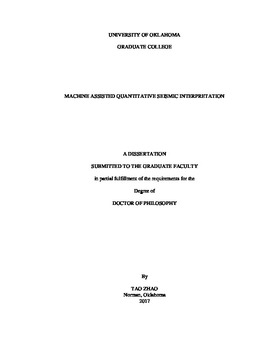| dc.description.abstract | During the past decades, the size of 3D seismic data volumes and the number of seismic attributes have increased to the extent that it is difficult, if not impossible, for interpreters to examine every seismic line and time slice. Reducing the labor associated with seismic interpretation while increasing the reliability of the interpreted result has been an on going challenge that becomes increasingly more difficult with the amount of data available to interpreters. To address this issue, geoscientists often adopt concepts and algorithms from fields such as image processing, signal processing, and statistics, with much of the focus on auto-picking and automatic seismic facies analysis. I focus my research on adapting and improving machine learning and pattern recognition methods for automatic seismic facies analysis. Being an emerging and rapid developing topic, there is an endless list of machine learning and pattern recognition techniques available to scientific researchers. More often, the obstacle that prevents geoscientists from using such techniques is the “black box” nature of such techniques. Interpreters may not know the assumptions and limitations of a given technique, resulting in subsequent choices that may be suboptimum. In this dissertation, I provide a review of the more commonly used seismic facies analysis algorithms. My goal is to assist seismic interpreters in choosing the best method for a specific problem. Moreover, because all these methods are just generic mathematic tools that solve highly abstract, analytical problems, we have to tailor them to fit seismic interpretation problems. Self-organizing map (SOM) is a popular unsupervised learning technique that interpreters use to explore seismic facies using multiple seismic attributes as input. It projects the high dimensional seismic attribute data onto a lower dimensional (usually 2D) space in which interpreters are able to identify clusters of seismic facies. In this dissertation, using SOM as an example, I provide three improvements on the traditional algorithm, in order to present the information residing in the seismic attributes more adequately, and therefore reducing the uncertainly in the generated seismic facies map. | en_US |
